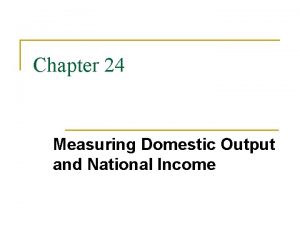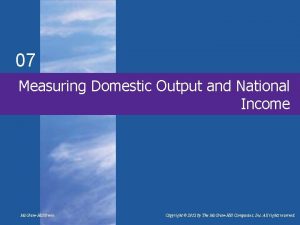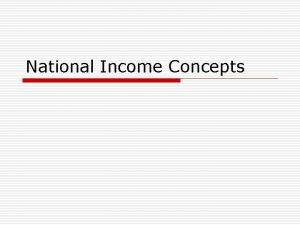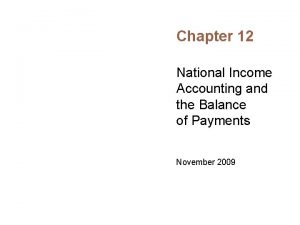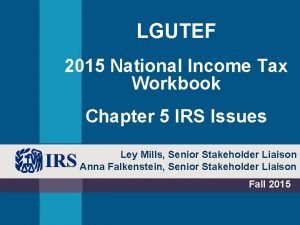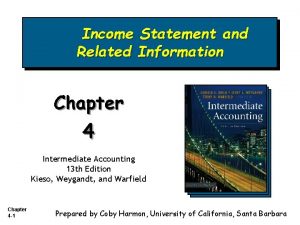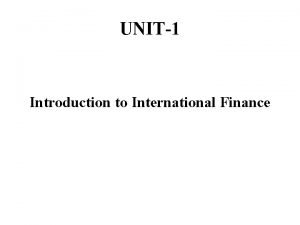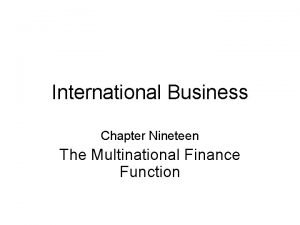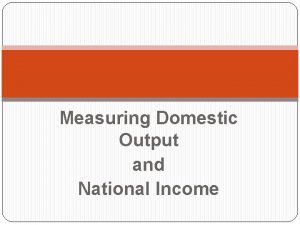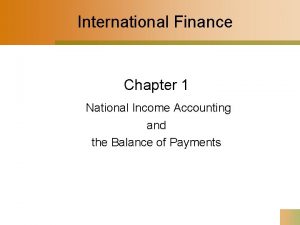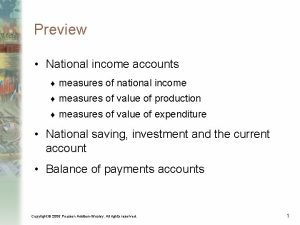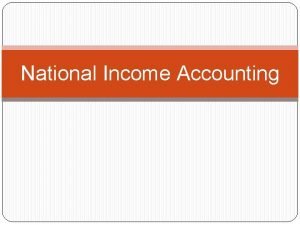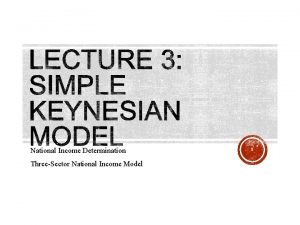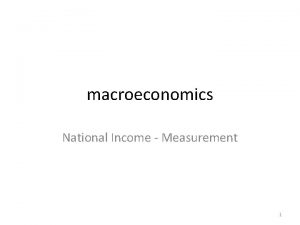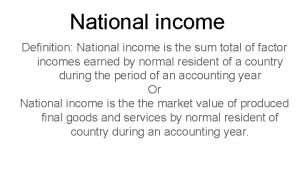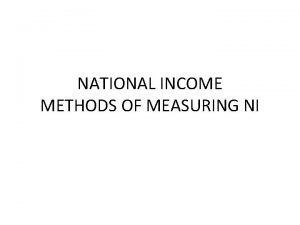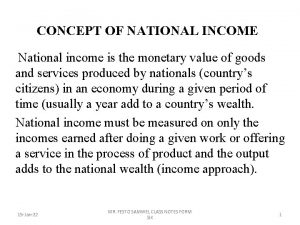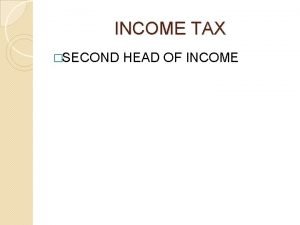International Finance Chapter 5 National and International Income




































- Slides: 36

International Finance Chapter 5 National and International Income Accounting and the Balance of Payments

Chapter Introduction • So far, we have studied how exchange rates are determined in the short run and in the long run. • As a macroeconomic variable, exchange rates directly affect international trade in goods and services as well as international investments and financial transactions. • In this chapter, we first study the international accounting system of trade and payments. Next, we examine how international transactions relate to national income and wealth.

Chapter Outline • National income accounts – GNE, GDP, GNI, & GNDI – Current account • National saving, investment, and the current account • Balance of payments accounts

National Income Accounts • Gross National Expenditure GNE = C + I +G • Expenditure approach gives GDP = C + I + G + EX – IM • Trade Balance TB = EX - IM – If TB > 0, exports > imports trade surplus – If TB < 0, exports < imports trade deficit

National Income Accounts From GDP to GNI: Accounting for Trade in Factor Services • Gross national income equals gross domestic product (GDP) plus net factor income from abroad (NFIA).

Ireland GDP vs. GNI A Paper Tiger? The chart shows trends in GDP, GNI, and NFIA in Ireland from 1980 to 2011. Irish GNI per capita grew more slowly than GDP per capita during the boom years of the 1980 s and 1990 s because an everlarger share of GDP was sent abroad as net factor income to foreign investors. Close to zero in 1980, this share had risen to around 15% of GDP by the year 2000 and has remained there. 6

National Income Accounts From GNI to GNDI: Accounting for Transfers of Income If a country receives transfers worth UTIN and gives transfers worth UTOUT, then its net unilateral transfers (NUT), are NUT = UTIN − UTOUT. Adding net unilateral transfers to gross national income, gives a full measure of national income in an open economy, known as gross national disposable income (GNDI), henceforth Y:

From GNI to GNDI: Accounting for Transfers of Income Major Transfer Recipients The chart shows average figures for 2000 to 2010 for all countries in which net unilateral transfers exceeded 15% of GNI. Many of the countries shown were heavily reliant on foreign aid, including some of the poorest countries in the world, such as Liberia, Eritrea, Malawi, and Nepal. Some countries with higher incomes also have large transfers because of substantial migrant remittances from a large number of emigrant workers overseas (e. g. , Tonga, El Salvador, Honduras, and Cape Verde). 8

National Income Accounts What the National Economic Aggregates Tell Us • On the left is our full income measure, GNDI. • The first term on the right is GNE, which measures payments by home entities. • The remaining terms measure net payments to the home country from all international transactions in goods, services, and income. We group the three cross-border terms into an umbrella term that is called the current account (CA).

National Income Accounts U. S. Economic Aggregates in 2012 The table shows the computation of GDP, GNI, and GNDI in 2012 in billions of dollars using the components of gross national expenditure, the trade balance, international income payments, and unilateral transfers.

National Income Accounts U. S. Current Accounts and Its Components, 1990 -2012 The figure shows the trade balance (TB), net factor income from abroad (NFIA), and net unilateral transfers (NUT) in billions of dollars.

National saving, investment, and the current account • This equation is the open-economy national income identity. It tells us that the current account represents the difference between national income Y (or GNDI) and gross national expenditure GNE (or C + I + G). Hence: • GNDI is greater than GNE if and only if CA is positive, or in surplus. • GNDI is less than GNE if and only if CA is negative, or in deficit.

National saving, investment, and the current account • • Private saving (Sp) = Y – C – T Public saving (Sg) = T – G National saving (S) = Sp + Sg = Y – C – G So, S = I + CA; CA = S – If S > I, the excess saving will be invested in foreign assets (capital outflow); – If S < I, the excess investment will have to be financed by foreign borrowing (capital inflow). – CA = net foreign investment = net foreign wealth

National saving, investment, and the current account Global Imbalances The charts show saving (blue), investment (red), and the current account (beige) as a percent of GDP.

National saving, investment, and the current account Global Imbalances (continued) In the 1990 s, emerging markets moved into current account surplus and thus financed the overall trend toward current account deficit of the industrial countries. Note: Oil producers include Norway.

National saving, investment, and the current account Private and Public Saving Trends: Industrial Countries This chart shows private saving and the chart on the next slide public saving, both as a percent of GDP. Private saving has been declining in the industrial countries, especially in Japan (since the 1970 s) and in the United States (since the 1980 s). Private saving has been more stable in the Euro area and other countries.

National saving, investment, and the current account Private and Public Saving Trends: Industrial Countries (continued) Public saving is clearly more volatile than private saving. Japan has been mostly in surplus and massively so in the late 1980 s and early 1990 s. The United States briefly ran a government surplus in the late 1990 s but has now returned to a deficit position.

Twin Deficits • CA = Sp – I – (G – T) – If Sp and I remain constant, a high government deficit (G – T) generates a high current account deficit. – In reality, Sp and I probably won’t remain constant.

Balance of Payments • BOP is a report of one country’s transactions with other countries. • Double-entry bookkeeping: a transaction enters the accounts twice: a credit (+) and a debit (-) – A Payment received is reported as a credit; – A payment made is reported as a debit. • Components of BOP – Current account: flows of goods, services, income, unilateral transfers; – Financial account: real assets, financial assets, and official reserve assets; – Capital account: non-market, non-produced, or intangible assets; and statistical discrepancy.

Examples of BOP Double-Entry BK • You invest in the Japanese stock market by buying $500 in Sony stock. • Sony deposits the money in its Los Angeles bank account. The bank credits the account by the amount of the deposit. Purchase of stock (financial account) Credit (“sale”) of deposit in account by bank (financial account) –$500 +$500

Examples (Cont. ) • GM exports $2 million worth of automobiles to China. • China’s importer pays for the automobiles by writing a check with its Citi Bank account. Automobile sales +$2, 000 (current account) Deduction of Chinese importer’s US$ account at Citi Bank (financial account) -$2, 000

Examples (Cont. ) • U. S. banks forgive a $100 M debt owed by the government of Argentina through debt restructuring. • U. S. banks who hold the debt thereby reduce the debt by crediting Argentina's bank accounts. Debt forgiveness: non-market transfer (capital account) Credit (“sale”) of account by bank (financial account) –$100 M +$100 M

Examples (Cont. ) • A private charity in the U. S. ships $50, 000 worth of goods as aid following an hurricane that devastated the southeast region of Taiwan. 23

Examples (Cont. ) • A private charity in the U. S. ships $50, 000 worth of goods as aid following an hurricane that devastated the southeast region of Taiwan. Exports of goods from U. S. (current account) Unilateral transfer (financial account) $50, 000 -$50, 000 24

The Balance of BOP • Due to double-entry book keeping, the BOP will balance as Current account + Financial account + Capital account = 0

Balance of Payments The U. S. Balance of Payments in 2012 The table shows U. S. international transactions in 2012 in billions of dollars. Major categories are in bold type.

Balance of Payments The U. S. Balance of Payments in 2012 (continued) The table shows U. S. international transactions in 2012 in billions of dollars. Major categories are in bold type.

Balance of Payments The U. S. Balance of Payments in 2012 (continued) The table shows U. S. international transactions in 2012 in billions of dollars. Major categories are in bold type.

Official Reserve Assets • Official (foreign) reserve assets: foreign assets held by central banks to cushion against financial instability. – Assets include government bonds, currency, gold and accounts at the International Monetary Fund. – Official reserve assets owned by (sold to) foreign central banks are a credit (+) because the domestic central bank can spend more money to cushion againstability. – Official reserve assets owned by (purchased by) the domestic central bank are a debit (-) because the domestic central bank can spend less money to cushion againstability.

Official Reserve Assets • The negative value of the official reserve assets is called the official settlements balance or “balance of payments. ” – It is the sum of the current account, the capital account, the non-reserve portion of the financial account, and the statistical discrepancy. – A negative official settlements balance may indicate that a country • is depleting its official foreign reserve assets or • may be incurring large debts to foreign central banks so that the domestic central bank can spend a lot to protect against financial instability.

Net Foreign Wealth • A country’s net foreign wealth is also called its net international investment position. (Note that it is a stock measure, not a flow measure). If W > 0, home is a net creditor country: external assets exceed external liabilities. If W < 0, home is a net debtor country: external liabilities exceed external assets. 31

Net Foreign Wealth What External Wealth Tells Us • External wealth data tell us the net credit or debit position of a country with respect to the rest of the world. • They include data on external assets (foreign assets owned by the home country) and external liabilities (home assets owned by foreigners). • A creditor country has positive external wealth, a debtor country has negative external wealth. • Countries with a current account surplus (deficit) must be net buyers (sellers) of assets. 32

Net Foreign Wealth What External Wealth Tells Us (Cont. ) • An increase in a country’s external wealth results from every net import of assets; conversely, a decrease in external wealth results from every net export of assets. • In addition, countries can experience capital gains or losses on their external assets and liabilities that cause changes in external wealth. • All of these changes are summarized in the statement of a country’s net international investment position. 33

Net Foreign Wealth • The U. S. has the most negative net foreign wealth in the world, and so is therefore the world’s largest debtor nation. • Its current account deficit in 2014 was $389. 5 billion dollars, so net foreign wealth continues to decrease. • The value of foreign assets held by the U. S. has grown since 1980, but liabilities of the U. S. (debt held by foreigners) has grown faster.

U. S. Gross Foreign Assets and Liabilities ($billions), 1976 - 2014 Source: U. S. Department of Commerce, Bureau of Economic Analysis,

Net Foreign Wealth • About 70% of foreign assets held by the U. S. are denominated in foreign currencies and almost all of U. S. liabilities (debt) are denominated in dollars. • Changes in the exchange rate influence value of net foreign wealth (gross foreign assets minus gross foreign liabilities). – Appreciation of the value of foreign currencies makes foreign assets held by the U. S. more valuable, but does not change the dollar value of dollar-denominated debt for the U. S.
 Gdp per capita formula
Gdp per capita formula Ttd and dtd
Ttd and dtd Statement of other comprehensive income
Statement of other comprehensive income Accounting income vs taxable income
Accounting income vs taxable income The national income and product accounts
The national income and product accounts Measuring domestic output and national income
Measuring domestic output and national income Outputs
Outputs Measuring domestic output and national income
Measuring domestic output and national income Measuring domestic output and national income
Measuring domestic output and national income Ano ang mga pamamaraan ng national income accounting
Ano ang mga pamamaraan ng national income accounting National income formula
National income formula National income lesson plan
National income lesson plan National income formula
National income formula National income tax workbook
National income tax workbook Solve the national income model by matrix inversion
Solve the national income model by matrix inversion Final expenditure approach
Final expenditure approach What is national income
What is national income National income accounting equation
National income accounting equation International business finance and economics
International business finance and economics Ifslearning
Ifslearning Nature of international finance
Nature of international finance International accounting and finance
International accounting and finance International trade and finance topics
International trade and finance topics National finance commission
National finance commission National finance commission
National finance commission National finance center
National finance center Berney v tronoh mines
Berney v tronoh mines Fdt sellus
Fdt sellus National unification and the national state
National unification and the national state Chapter 2 income benefits and taxes
Chapter 2 income benefits and taxes Chapter 23 understanding income and taxes
Chapter 23 understanding income and taxes Intermediate accounting chapter 4
Intermediate accounting chapter 4 International finance syllabus
International finance syllabus Finance function of international business
Finance function of international business International finance logo
International finance logo Expanded opportunity set international finance
Expanded opportunity set international finance The current system of international finance is a *
The current system of international finance is a *





